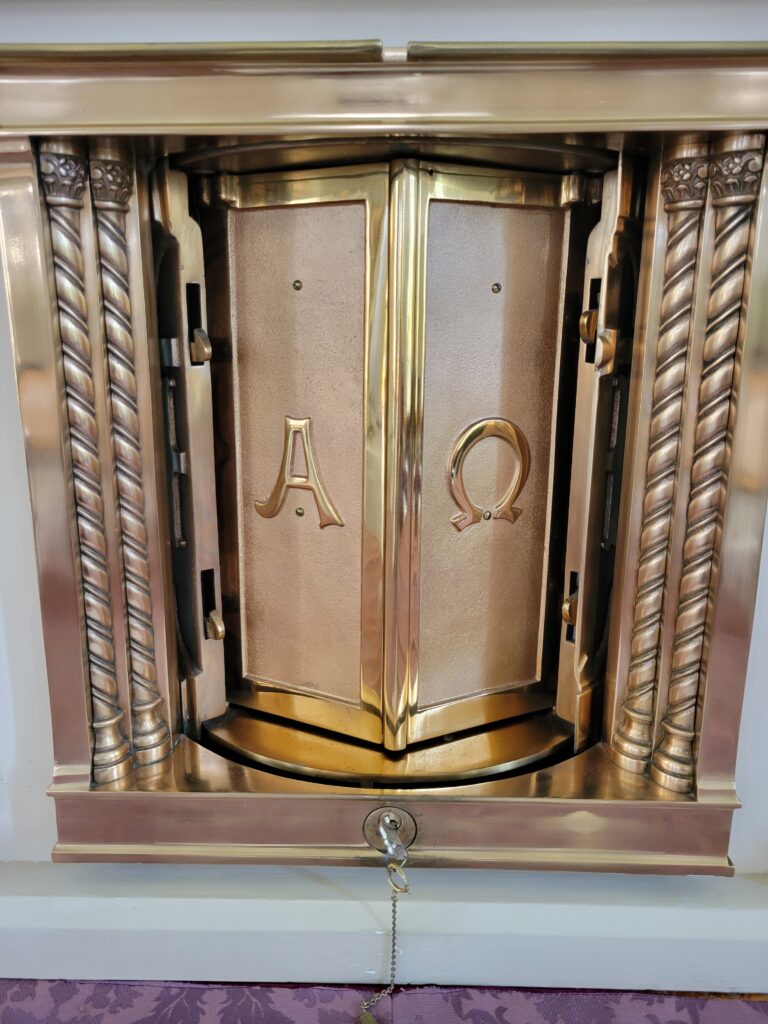Eucharistic Jesus Is With Us Day and Night

When we enter the church, immediately our sight is directed to the high altar and a golden box in the center of the altar. This box which is made from highly polished brass is sacred, set apart for a very special purpose. It is the most distinctive fixture of any Catholic church. We call the box a tabernacle and it contains the “holy of holies” – Jesus present in the Eucharist. Next to it, you will find a red vigil lamp. This lamp is to indicate and honor the presence of Christ and is kept lit day and night.
The word tabernacle (Latin: tabernaculum) means “dwelling place” and refers to the “tent of meeting” that the Israelites built to facilitate their worship of God in the desert (the Book of Exodus, chapter 26). Sacrifices were offered within that Tabernacle and four things were kept inside: the Ark of the Covenant, the golden lampstand (Menorah), the golden table of the Bread of the Presence and manna. Both the manna and the Bread of the Presence (a sacrificial offering of bread that was eaten by the priests, along with wine) have distinct parallels to the Eucharist that Catholics consume and are seen as prefigurements of it.
When celebrating the Mass, the early Christians knew that they could not simply dispose of the left-over Eucharistic bread and, at first, because they were being persecuted and did not have churches, they distributed all the remaining hosts to be carried to the sick and home-bound.
When the persecution ended, Christians started to build churches and, at the same time, they added tabernacles to house the reserved Blessed Sacrament. The first tabernacles were often shaped like a golden dove within a tower suspended over the altar.
The Catechism of the Catholic Church explains that “the tabernacle was first intended for the reservation of the Eucharist in a worthy place so that it could be brought to the sick and those absent outside of Mass. As faith in the Real Presence of Christ in His Eucharist deepened, the Church became conscious of the meaning of silent adoration of the Lord present under the Eucharistic species” (CCC 1379).
The use of a tabernacle in Catholic churches rests solely on the doctrine of the Real Presence of Christ in the Eucharist – the knowledge that Jesus himself is truly present under the appearances of bread (and wine). In other words, the tabernacle is not used in a symbolic way, to symbolize God’s presence among us, but in a real way (like the Tabernacle of the Old Testament) to house and protect the Real Presence of God in the Eucharist.
This is also why Catholics genuflect when passing the tabernacle. We do so in honor of the Real Presence of Christ present in the Eucharistic bread reserved and protected in the tabernacle. The vigil lamp burns as a sign of Christ’s presence. On Holy Thursday night, after the Mass of the Lord’s Supper, the Blessed Sacrament is removed from the main tabernacle to an altar of repose elsewhere in the church, for a time of adoration. For the period from Holy Thursday night through the beginning of the Easter Vigil on Holy Saturday night, a time when we recall Jesus’ death and burial, the tabernacle is empty, with the door left open and the vigil lamp extinguished.



The tabernacle in our church is made from brass and is beautifully crafted. On the outside doors we can see the Greek letters IHS that are the first three letters of the name Jesus (HISOYS); the inner doors of our tabernacle have the Greek letters A and Ω, meaning Alpha and Omega. These are the first and the last letters of the Greek alphabet, and a title of Christ and God in the Book of Revelation – the last book of the Bible — “I am the Alpha and the Omega, the First and the Last, the Beginning and the End.” (Rev. 22:13). On the inner side of the inner doors, there are two angels with the inscription in Latin: Sanctus, Sanctus, Sanctus, Dominus Deus Sabaoth, which means: Holy, Holy, Holy Lord God of hosts.
Let us all give right and utmost praise to the Eucharistic Jesus present in our church. Let us receive Him during the Mass with the highest respect and faith, and adore Him while visiting the church at any time.
Fr. Mark Jurzyk
